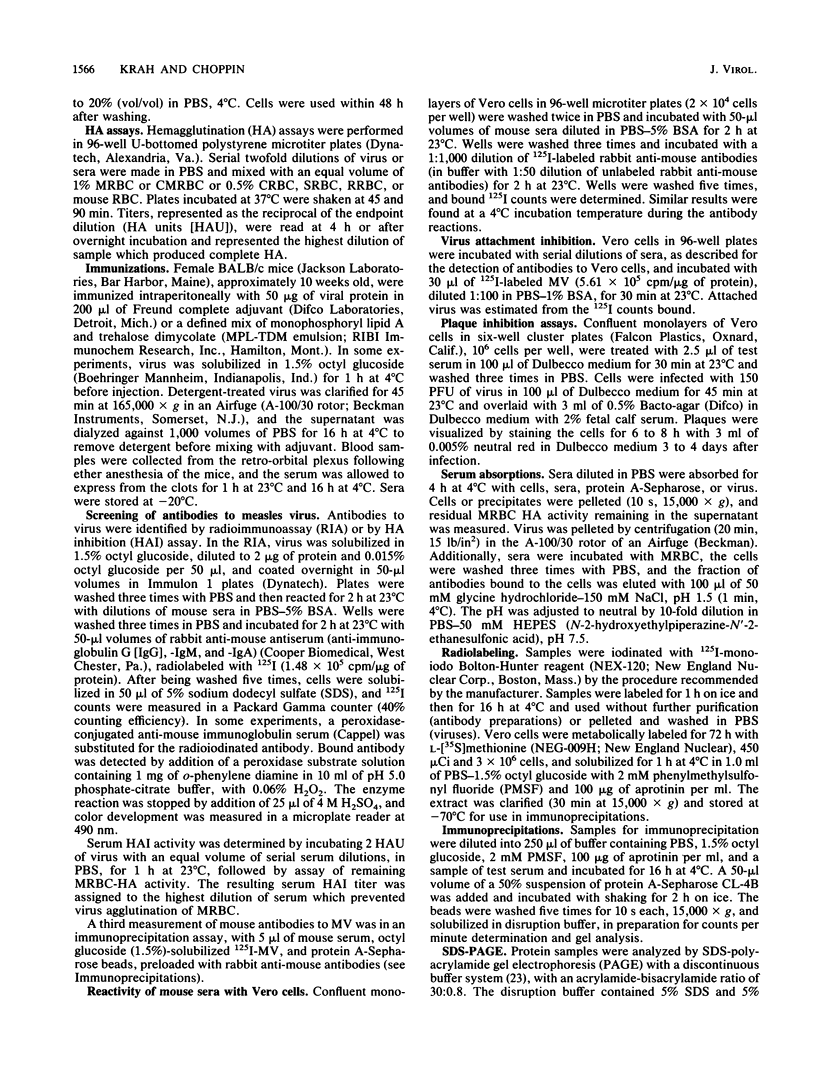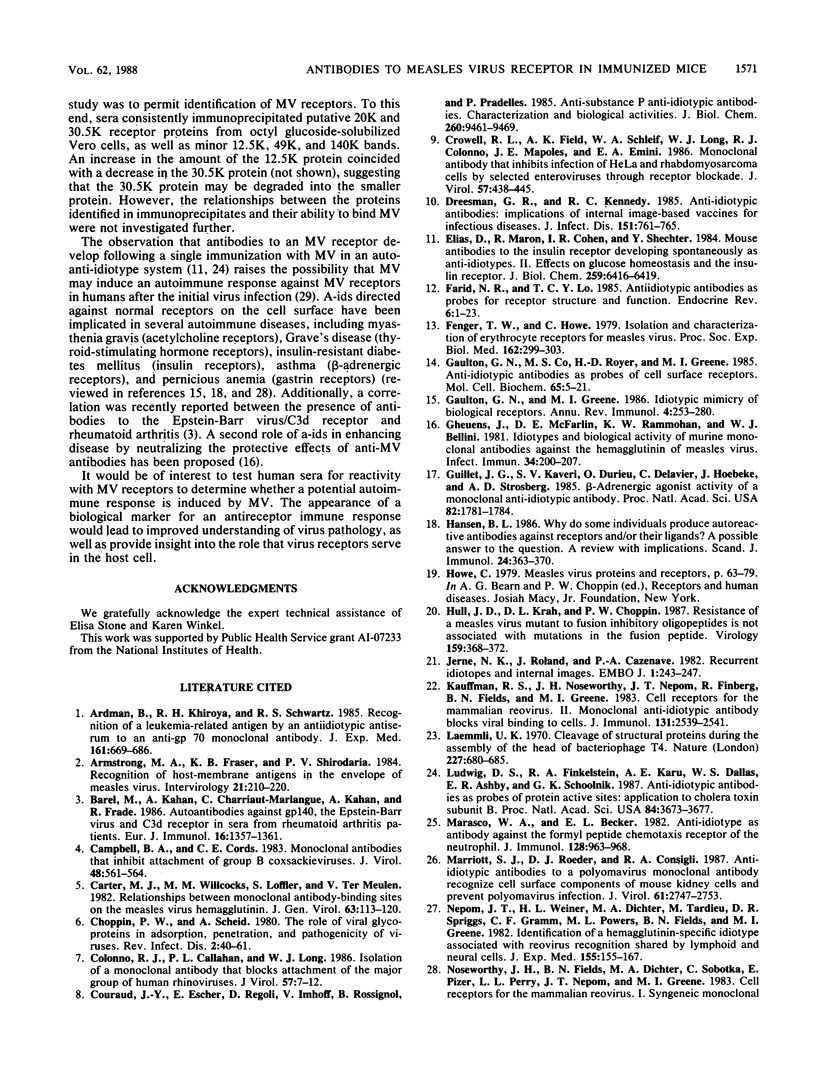Abstract
Mice were immunized with measles virus to determine whether an auto-anti-idiotypic antireceptor response could be generated as a probe for measles virus receptors. Mice initially responded to viral antigens (days 11 to 18) and subsequently developed antibodies to a putative measles virus receptor (peak at day 30 to 35) by three criteria: the sera (1) agglutinated erythrocytes which virus agglutinates, (2) reacted with Vero cells, and (3) inhibited virus attachment to Vero cells. Additionally, select sera inhibited virus infection of Vero cells. The cell-reactive activity was identified as immunoglobulin G antibody and was neutralized by sera reacting with virus (idiotype). The application of this anti-idiotypic antibody to identify measles virus-binding sites on Vero cells was revealed by the ability of sera to immunoprecipitate 20- and 30.5-kilodalton proteins from metabolically labeled ([35S]methionine) Vero cells.
Full text
PDF







Images in this article
Selected References
These references are in PubMed. This may not be the complete list of references from this article.
- Ardman B., Khiroya R. H., Schwartz R. S. Recognition of a leukemia-related antigen by an antiidiotypic antiserum to an anti-gp70 monoclonal antibody. J Exp Med. 1985 Apr 1;161(4):669–686. doi: 10.1084/jem.161.4.669. [DOI] [PMC free article] [PubMed] [Google Scholar]
- Armstrong M. A., Fraser K. B., Shirodaria P. V. Recognition of host-membrane antigens in the envelope of measles virions. Intervirology. 1984;21(4):210–220. doi: 10.1159/000149559. [DOI] [PubMed] [Google Scholar]
- Barel M., Kahan A., Charriaut-Marlangue C., Kahan A., Frade R. Autoantibodies against gp140, the Epstein-Barr virus and C3d receptor in sera from rheumatoid arthritis patients. Eur J Immunol. 1986 Nov;16(11):1357–1361. doi: 10.1002/eji.1830161108. [DOI] [PubMed] [Google Scholar]
- Campbell B. A., Cords C. E. Monoclonal antibodies that inhibit attachment of group B coxsackieviruses. J Virol. 1983 Nov;48(2):561–564. doi: 10.1128/jvi.48.2.561-564.1983. [DOI] [PMC free article] [PubMed] [Google Scholar]
- Carter M. J., Willcocks M. M., Löffler S., ter Meulen V. Relationships between monoclonal antibody-binding sites on the measles virus haemagglutinin. J Gen Virol. 1982 Nov;63(Pt 1):113–120. doi: 10.1099/0022-1317-63-1-113. [DOI] [PubMed] [Google Scholar]
- Choppin P. W., Scheid A. The role of viral glycoproteins in adsorption, penetration, and pathogenicity of viruses. Rev Infect Dis. 1980 Jan-Feb;2(1):40–61. doi: 10.1093/clinids/2.1.40. [DOI] [PubMed] [Google Scholar]
- Colonno R. J., Callahan P. L., Long W. J. Isolation of a monoclonal antibody that blocks attachment of the major group of human rhinoviruses. J Virol. 1986 Jan;57(1):7–12. doi: 10.1128/jvi.57.1.7-12.1986. [DOI] [PMC free article] [PubMed] [Google Scholar]
- Couraud J. Y., Escher E., Regoli D., Imhoff V., Rossignol B., Pradelles P. Anti-substance P anti-idiotypic antibodies. Characterization and biological activities. J Biol Chem. 1985 Aug 5;260(16):9461–9469. [PubMed] [Google Scholar]
- Crowell R. L., Field A. K., Schleif W. A., Long W. L., Colonno R. J., Mapoles J. E., Emini E. A. Monoclonal antibody that inhibits infection of HeLa and rhabdomyosarcoma cells by selected enteroviruses through receptor blockade. J Virol. 1986 Feb;57(2):438–445. doi: 10.1128/jvi.57.2.438-445.1986. [DOI] [PMC free article] [PubMed] [Google Scholar]
- Dreesman G. R., Kennedy R. C. Anti-idiotypic antibodies: implications of internal image-based vaccines for infectious diseases. J Infect Dis. 1985 May;151(5):761–765. doi: 10.1093/infdis/151.5.761. [DOI] [PubMed] [Google Scholar]
- Elias D., Maron R., Cohen I. R., Schechter Y. Mouse antibodies to the insulin receptor developing spontaneously as anti-idiotypes. II. Effects on glucose homeostasis and the insulin receptor. J Biol Chem. 1984 May 25;259(10):6416–6419. [PubMed] [Google Scholar]
- Farid N. R., Lo T. C. Antiidiotypic antibodies as probes for receptor structure and function. Endocr Rev. 1985 Winter;6(1):1–23. doi: 10.1210/edrv-6-1-1. [DOI] [PubMed] [Google Scholar]
- Fenger T. W., Howe C. Isolation and characterization of erythrocyte receptors for measles virus. Proc Soc Exp Biol Med. 1979 Nov;162(2):299–303. doi: 10.3181/00379727-162-40669. [DOI] [PubMed] [Google Scholar]
- Gaulton G. N., Co M. S., Royer H. D., Greene M. I. Anti-idiotypic antibodies as probes of cell surface receptors. Mol Cell Biochem. 1984 Nov;65(1):5–21. doi: 10.1007/BF00226015. [DOI] [PubMed] [Google Scholar]
- Gaulton G. N., Greene M. I. Idiotypic mimicry of biological receptors. Annu Rev Immunol. 1986;4:253–280. doi: 10.1146/annurev.iy.04.040186.001345. [DOI] [PubMed] [Google Scholar]
- Gheuens J., McFarlin D. E., Rammohan K. W., Bellini W. J. Idiotypes and biological activity of murine monoclonal antibodies against the hemagglutinin of measles virus. Infect Immun. 1981 Oct;34(1):200–207. doi: 10.1128/iai.34.1.200-207.1981. [DOI] [PMC free article] [PubMed] [Google Scholar]
- Guillet J. G., Kaveri S. V., Durieu O., Delavier C., Hoebeke J., Strosberg A. D. beta-Adrenergic agonist activity of a monoclonal anti-idiotypic antibody. Proc Natl Acad Sci U S A. 1985 Mar;82(6):1781–1784. doi: 10.1073/pnas.82.6.1781. [DOI] [PMC free article] [PubMed] [Google Scholar]
- Hansen B. L. Why do some individuals produce autoreactive antibodies against receptors and/or their ligands? A possible answer to the question. A review with implications. Scand J Immunol. 1986 Oct;24(4):363–370. doi: 10.1111/j.1365-3083.1986.tb02123.x. [DOI] [PubMed] [Google Scholar]
- Hull J. D., Krah D. L., Choppin P. W. Resistance of a measles virus mutant to fusion inhibitory oligopeptides is not associated with mutations in the fusion peptide. Virology. 1987 Aug;159(2):368–372. doi: 10.1016/0042-6822(87)90475-2. [DOI] [PubMed] [Google Scholar]
- Jerne N. K., Roland J., Cazenave P. A. Recurrent idiotopes and internal images. EMBO J. 1982;1(2):243–247. doi: 10.1002/j.1460-2075.1982.tb01154.x. [DOI] [PMC free article] [PubMed] [Google Scholar]
- Kauffman R. S., Noseworthy J. H., Nepom J. T., Finberg R., Fields B. N., Greene M. I. Cell receptors for the mammalian reovirus. II. Monoclonal anti-idiotypic antibody blocks viral binding to cells. J Immunol. 1983 Nov;131(5):2539–2541. [PubMed] [Google Scholar]
- Laemmli U. K. Cleavage of structural proteins during the assembly of the head of bacteriophage T4. Nature. 1970 Aug 15;227(5259):680–685. doi: 10.1038/227680a0. [DOI] [PubMed] [Google Scholar]
- Ludwig D. S., Finkelstein R. A., Karu A. E., Dallas W. S., Ashby E. R., Schoolnik G. K. Anti-idiotypic antibodies as probes of protein active sites: application to cholera toxin subunit B. Proc Natl Acad Sci U S A. 1987 Jun;84(11):3673–3677. doi: 10.1073/pnas.84.11.3673. [DOI] [PMC free article] [PubMed] [Google Scholar]
- Marasco W. A., Becker E. L. Anti-idiotype as antibody against the formyl peptide chemotaxis receptor of the neutrophil. J Immunol. 1982 Feb;128(2):963–968. [PubMed] [Google Scholar]
- Marriott S. J., Roeder D. J., Consigli R. A. Anti-idiotypic antibodies to a polyomavirus monoclonal antibody recognize cell surface components of mouse kidney cells and prevent polyomavirus infection. J Virol. 1987 Sep;61(9):2747–2753. doi: 10.1128/jvi.61.9.2747-2753.1987. [DOI] [PMC free article] [PubMed] [Google Scholar]
- Nepom J. T., Weiner H. L., Dichter M. A., Tardieu M., Spriggs D. R., Gramm C. F., Powers M. L., Fields B. N., Greene M. I. Identification of a hemagglutinin-specific idiotype associated with reovirus recognition shared by lymphoid and neural cells. J Exp Med. 1982 Jan 1;155(1):155–167. doi: 10.1084/jem.155.1.155. [DOI] [PMC free article] [PubMed] [Google Scholar]
- Plotz P. H. Autoantibodies are anti-idiotype antibodies to antiviral antibodies. Lancet. 1983 Oct 8;2(8354):824–826. doi: 10.1016/s0140-6736(83)90740-7. [DOI] [PubMed] [Google Scholar]
- Sato T. A., Fukuda A., Sugiura A. Characterization of major structural proteins of measles virus with monoclonal antibodies. J Gen Virol. 1985 Jul;66(Pt 7):1397–1409. doi: 10.1099/0022-1317-66-7-1397. [DOI] [PubMed] [Google Scholar]
- Schreiber A. B., Couraud P. O., Andre C., Vray B., Strosberg A. D. Anti-alprenolol anti-idiotypic antibodies bind to beta-adrenergic receptors and modulate catecholamine-sensitive adenylate cyclase. Proc Natl Acad Sci U S A. 1980 Dec;77(12):7385–7389. doi: 10.1073/pnas.77.12.7385. [DOI] [PMC free article] [PubMed] [Google Scholar]
- Sege K., Peterson P. A. Use of anti-idiotypic antibodies as cell-surface receptor probes. Proc Natl Acad Sci U S A. 1978 May;75(5):2443–2447. doi: 10.1073/pnas.75.5.2443. [DOI] [PMC free article] [PubMed] [Google Scholar]
- Shechter Y., Elias D., Maron R., Cohen I. R. Mice immunized to insulin develop antibody to the insulin receptor. J Cell Biochem. 1983;21(2):179–185. doi: 10.1002/jcb.240210208. [DOI] [PubMed] [Google Scholar]
- Shechter Y., Elias D., Maron R., Cohen I. R. Mouse antibodies to the insulin receptor developing spontaneously as anti-idiotypes. I. Characterization of the antibodies. J Biol Chem. 1984 May 25;259(10):6411–6415. [PubMed] [Google Scholar]
- Sheshberadaran H., Norrby E. Characterization of epitopes on the measles virus hemagglutinin. Virology. 1986 Jul 15;152(1):58–65. doi: 10.1016/0042-6822(86)90371-5. [DOI] [PubMed] [Google Scholar]



